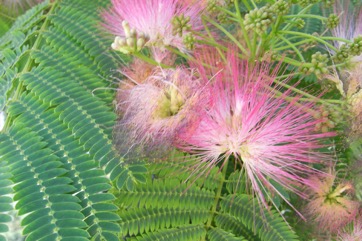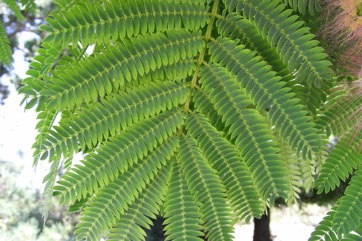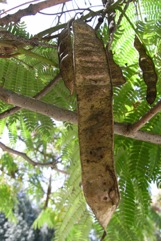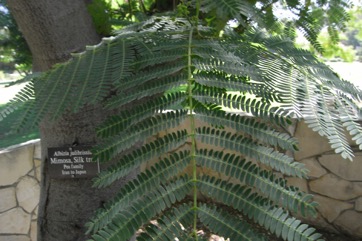Silk Tree, Siris

It is a temperate to tropical plant. It grows naturally from Iran to China in open sunny ravines, forests and by rivers up to 2100 metres in the Himalayas. It needs a well drained but moist soil but can grow in dry soil. They can tolerate high pH, salty soils, drought and wind. Trees when dormant are hardy to -10°C or in continental climates - 20°C. Young growth is frost tender. It suits hardiness zones 6-12. It grows well in places with cool winters and hot summers. Arboretum Tasmania. in Yunnan.
Also known as:
Hehuan, Ho huan, Hophoan, Nemu, Persian acacia, Pink siris, Seto siris, Shut happy, Vang-nyong
Synonyms
- Acacia julibrissin (Durazz.) Willd.
- Acacia nemu Willd.
- Albizia nemu (Willd.) Benth.
- Heuilleea julibrissin (Durazz.) Kuntze
- Mimosa julibrissin (Durazz.) Scop.
- Mimosa speciosa Thunb.
- Sericandra julibrissin (Durazz.) Scop.
- Acacia mollis Wallich
- ? Albizia mollis (Wallich) Boivin
- ?
Edible Portion
- Leaves, Flowers, Leaves - tea, Vegetable
Where does Silk Tree grow?
Found in: Afghanistan, Africa, Argentina, Asia, Australia, Bhutan, Brazil, Britain, Bulgaria, Canada, Caribbean, China, East Africa, East Timor, Greece, Himalayas, India, Indochina, Iran, Iraq, Italy, Jamaica, Japan, Korea, Mauritius, Mediterranean, Myanmar, Nepal, New Zealand, North America, Pakistan, Peru, Portugal, Russia, SE Asia, South America, Spain, Taiwan, Tasmania, Timor-Leste, Turkey, Uruguay, United States, Vietnam, Zimbabwe
Notes: There are 145-150 Albizia species. They grow in the tropics and subtropics. This one can become invasive. Also as Mimosaceae.
Growing Silk Tree, Siris
Cultivation: Plants can be grown from seed, cuttings or suckers. Seed need to be pre-soaked for 24 hours in hot water. They germinate in 2-3 months at 19°C. Plants can be transplanted. Plants can be pruned and shaped.
Edible Uses: The young leaves are cooked and eaten as a potherb. The flowers are eaten as a vegetable. The dried leaves are used as a tea.
Production: It is fast growing. Trees live for about 20 years.
Nutrition Info
per 100g edible portion| Edible Part | Energy (kcal) | Protein (g) | Iron (mg) | Vitamin A (ug) | Vitamin c (mg) | Zinc (mg) | % Water |
|---|---|---|---|---|---|---|---|
| Leaves | - | - | - | - | - | - | |
| Leaves - tea | - | - | - | - | - | - | |
| Flowers | - | - | - | - | - | - |
Silk Tree, Siris Photos




References
Bircher, A. G. & Bircher, W. H., 2000, Encyclopedia of Fruit Trees and Edible Flowering Plants in Egypt and the Subtropics. AUC Press. p 17
Blamey, M and Grey-Wilson, C., 2005, Wild flowers of the Mediterranean. A & C Black London. p 80
Bodkin, F., 1991, Encyclopedia Botanica. Cornstalk publishing, p 62
Brickell, C. (Ed.), 1999, The Royal Horticultural Society A-Z Encyclopedia of Garden Plants. Convent Garden Books. p 93
Brown, D., 2002, The Royal Horticultural Society encyclopedia of Herbs and their uses. DK Books. p 109
Coombes, A.J., 2000, Trees. Dorling Kindersley Handbooks. p 192
Cundall, P., (ed.), 2004, Gardening Australia: flora: the gardener's bible. ABC Books. p 122
Etherington, K., & Imwold, D., (Eds), 2001, Botanica's Trees & Shrubs. The illustrated A-Z of over 8500 trees and shrubs. Random House, Australia. p 84
Facciola, S., 1998, Cornucopia 2: a Source Book of Edible Plants. Kampong Publications, p 151
Hedrick, U.P., 1919, (Ed.), Sturtevant's edible plants of the world. p 31
ILDIS Legumes of the World http:www;ildis.org/Legume/Web
Kunkel,
Llamas, K.A., 2003, Tropical Flowering Plants. Timber Press. p 211
Lamberton, K (Ed.), 2004, The Australian gardening encyclodepia. Murdoch Books, NSW Australia. p 155
Little, E.L., 1980, National Audubon Society Field Guide to North American Trees. Alfred A. Knopf. p 517
Liu, Yi-tao, & Long, Chun-Lin, 2002, Studies on Edible Flowers Consumed by Ethnic Groups in Yunnan. Acta Botanica Yunnanica. 24(1):41-56
Mag. Tosc. 3(4):11. 1772
Manandhar, N.P., 2002, Plants and People of Nepal. Timber Press. Portland, Oregon. p 80
Marinelli, J. (Ed), 2004, Plant. DK. p 443
Pham-Hoang Ho, 1999, An Illustrated Flora of Vietnam. Nha Xuat Ban Tre. p 828
Plants for a Future database, The Field, Penpol, Lostwithiel, Cornwall, PL22 0NG, UK. http://www.scs.leeds.ac.uk/pfaf/
READ
Ryan, S., 2008, Dicksonia. Rare Plants Manual. Hyland House. p 7
Valder, P., 1999, The Garden Plants of China. Florilegium. p 263
Woo, Y., et al, 2017, Antioxidant Potential of Selected Korean Edible Plant Extracts. Hindawi BioMed Research International Volume 2017, Article ID 7695606
Young, J., (Ed.), 2001, Botanica's Pocket Trees and Shrubs. Random House. p 80